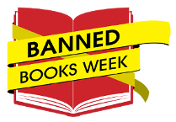This week is the annual Banned Books Week, where educators draw attention to the dangers of outright banning books in public schools and libraries. The list of “frequently banned and challenged books” tends to circulate, commonly eliciting a chorus of “Really, somebody has a problem with Judy Blume?”
While I believe than any book a public library can get its hands on ought to have space on a shelf somewhere in public access, I don’t think that elementary schools ought to be teaching Fifty Shades Darker even if it is written with the vocabulary and syntax of a fourth grader (so I hear…)
It is obvious that some common sense ought to be exercised as teachers and schools make curricular decisions.
I have long held the view that one of the most powerful reasons that we teach literature is that it affords us the opportunity to examine the world as a third point: This text, this thing we can hold in our hands, is separate from you and me and even in a way separate from the “real world.” Yet in all that the fictional text remains still a version of the world, as that third point is one we can use to safely talk about the beauty and the ugliness, the heroes and the villains, the fallacy of such dichotomies and the reality of the muddy middle ground, thereby using literature as a proxy to actually learn about the complexity of humanity.
I see my role, both when I operate as teacher but also when I operate as parent for my own offspring, in a sense as being a tour guide to offer the first commentary and mediation of these young peoples’ forays into reality via literature. I don’t teach books to titillate or provoke or manipulate. When those titillating or provocative or manipulative passages appear on the page, my role is to ask questions and to help the child understand how to think on their own on these artificial pages out of the hope that they will build the skills to know what to do when they face something real that is titillating, provocative, or manipulative.
A parent has the right to determine what a child should or should not read (or watch) in school. As a parent myself I understand that impulse of parenthood to protect and shield. Responsible schools, however, have clear policies and processes for approving works of literature that are used in classes. In many schools, this includes vetting with community stakeholders. Decisions about curriculum are rarely rushed through. We do deeply and thoroughly consider the manner in which texts we teach handle potentially sensitive subjects. Wise policy around selection of literature is mindful of how to intentionally broach the kinds of social, personal, and political issues that shouldn’t end up as gross and destabilizing surprises on your 18th birthday…you know, that magic moment when you suddenly become a grown-up able to handle all sorts of grown-up realities simply by virtue of a change on the calendar.
I worry, though, about our culture already and our growing inability to tolerate the existence of views divergent from our own. If we guard children from reading and thinking about the world, what happens when they eventually do face it fully and are forced to see that it perhaps isn’t what our childhood illusions of it made it seem to be?
Maybe I’ll just let this Emily Dickinson poem, one my favorites to teach, make my point:
Tell all the Truth but tell it slant–
Success in Circuit lies
Too bright for our infirm Delight
The Truth’s superb surprise
As Lightning to the Children eased
With explanation kind
The Truth must dazzle gradually
Or every man be blind–

Banned books make absolutely no sense in high school, or anywhere else, for that matter. Teachers should have the freedom to choose the books they feel are appropriate for their students.